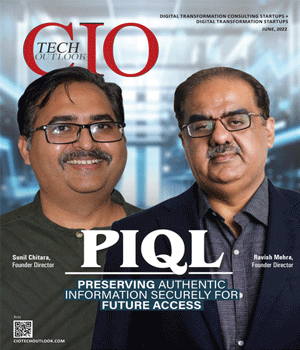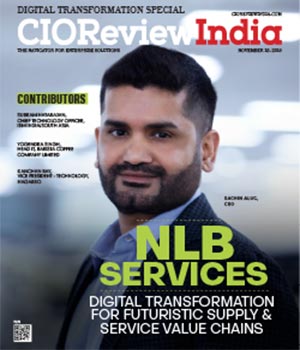
Strategies to Enhance Operational Activities & Implement Digital Solutions
Janifha Evangeline | Sunday, 18 June 2023, 19:56 IST

In an interaction with CIOTechOutlook, Ameya Waingankar, Engagement Partner – (Performance Improvement) & Director - Client Success at Practus walks us through the methods for enhancing operational activities as well as the strategies he implements for introducing digital solutions in enterprises. Ameya brings with him close to 13 years of experience in management consulting with a focus on technology-enabled business transformation.
Talk about your achievements in the digital transformation projects, such as how you boosted productivity, enhanced corporate procedures, or stimulated creativity. What are the most prevalent digital business trends?
Driven successful digital strategy and transformation mandates across large and mid-sized organizations spanning diverse industries such as Manufacturing, Oil & Gas, Real Estate, Mining, FMCG, Retail etc. Leading/Successful Organizations are:
Building resilience and agility: Being digitally nimble and look at evolving business models for changing conditions.
Investing disproportionately: in building their technology capabilities and own tech assets.
Creating a strong network effect: Effective at partnering and building a wider pool of ecosystem to tap into.
Innovating rapidly and at scale: compared to the peers.
The cost of introducing emerging digital technologies and implementation timeline has been reducing and it has thereby broken down the adoption barriers considerably. Still very few organizations have the risk appetite to be the early movers in adopting new-age technologies with many still wanting to be the followers and take the proven case study route.
Today, companies are extensively using digital technologies to achieve tangible business goals which few years back were unimaginable. Few examples include AI/ML for hyper personalization of services/touchpoints to end consumers, demand and inventory forecasting, IoT for shop floor and supply chain visibility, Industry 4.0 for driving operational efficiencies, AR/VR for building boundary-less customer experience centres, immersive safety training, Digital twins to simulate factory operations and foresee potential problems in supply chain and RPAs to automate repetitive tasks and eliminate manual interventions.
With a steep technology adoption curve expected in the near future, organizations are increasingly emphasizing on improving their cyber security posture. A well thought through digital architecture is imperative to the successful realization of the firm’s business goals.
What are the key strategies for implementing digital solutions in businesses, as well as their success factors that has historically been slow to adopt new technologies?
Key Strategies/Considerations for implementing digital solutions in businesses include:
Strategic alignment: Embed digital strategy as a part of your overall business strategy, build a digital and continuous innovation culture in the organization, functional ownership and leadership buy-in and digital native human capital.
Look at the Big Picture: Future readiness and potential business disruptions, changing business models and competitive landscape, building organizational resilience, and growth/Scalability at pace.
Harness the full potential of digital and create strong digital value stories: Constrained free conceptualization of tech enabled business solutions, build an integrated ecosystem, enhance digital experience for your internal and external stakeholders.
Data as an asset: Infuse a data driven decision making thrust across the enterprise value chain.
What methods do you employ to enhance operational activities? What steps would you take to improve this business’s reputation in the marketplace?
Some of the methods include articulation of business problems/challenges and objectives, identify all the stakeholders involved and the potential touchpoints, bucket the areas under various business lens. For example: shop floor visibility, automation of routine/mundane activities, customer experience, operational performance improvement (increased throughput, reduced fuel cost, reduction in unplanned breakdown, increased forecasting accuracy etc.), identify the digital technologies and solution themes to address the business scenarios, build cost-benefit analysis for each area and align with the respective functional owners, and design the operating model to drive the initiatives, monitor progress, adoption and value realization.
How can you be sure that digital transformation activities are in compliance with the primary goals which is long-lasting and sustainable?
Digital landscapes and the possibilities on offer are evolving so rapidly that it becomes critical to stay relevant and ahead of the curve. Recent example is of Generative AI pushing organizations back to the drawing board to revisit their product/service offerings and repurposing their human capital.
Early strategic alignment is key to ensure the firm remains on track with its primary business goals. Companies who are able to successfully realize and sustain their digital goals: Ensure business and digital strategy alignment, design a well-defined technology roadmap with clear business cases charted out for the short, medium and long term, identify digital champions who will drive the digital initiatives and will be responsible for the business outcomes, and drive robust governance through a digital review board with interim checkpoints and course corrections.
How do you integrate innovation into your current business models and operations? What are some IT competencies to realize its transformation?
In today’s age Business as Usual (BAU) is deemed as a more risker approach than driving innovation at scale. Therefore, innovation needs to be nurtured across levels within the organization, organizations today are building innovation hubs as a dedicated capability center or tapping into the external ecosystem to revamp their business models, future readiness and riding the wave of disruptions through an opportunity lens has a higher CXO mindshare and the key is to point the digital roadmap compass to the innovation driven business goals and drive them collaboratively.
CIO Viewpoint
The Constantly Evolving Technology Landscape in...
By Janifha Evangeline
Navigating the Digitalization of Mining Industry
By Janifha Evangeline
How To Achieve An Effective Digital Transformation
By Yogendra Singh, Head-IT/SAP, Barista Coffee Company Limited
CXO Insights
No-code platforms: Enterprise-wide Adoption...
By Rahul Murthi, Director at Acies
Unleashing the Potential of IT in Engineering...
By Gyan Pandey, Head - Digital/CDO, Voltas
Low Code and Artificial Intelligence - The...



.jpg)

.jpg)





